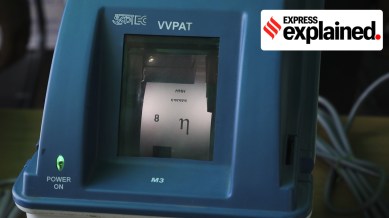With the first phase of voting set to take place on April 19, the Supreme Court (SC) last week said that petitions seeking 100% verification of Voter Verified Paper Audit Trail (VVPAT) slips would be taken up soon.
In March 2023, the Association for Democratic Reforms had filed a petition before the apex court saying that to ensure free and fair elections, the tally from Electronic Voting Machines (EVMs) should be cross-verified with the VVPATs. To make sure that this process is carried out as fast as possible, ADR suggested the use of barcodes on VVPAT slips.
What is a VVPAT machine? How does it work?
The VVPAT machine is attached to the ballot unit of the EVM, and provides visual verification for the vote cast by a voter by printing a slip of paper with the voter’s choice on it. This slip of paper, containing the candidate’s serial number, name, and party symbol, is displayed in the machine behind a glass window, giving the voter seven seconds to verify her vote. Following this, the slip falls into a compartment underneath.
No voter can take the VVPAT slip back home, as it is later used to verify votes cast in five randomly selected polling booths. The idea is that by allowing for a physical verification of the electronically cast vote, both voters and political parties have greater faith in the process — that their vote is being recorded correctly.
Why did the Election Commission introduce VVPATs?
The idea of the VVPAT machine first emerged in 2010, when the Election Commission of India (EC), held a meeting with political parties to discuss how to make the EVM-based polling process more transparent.
After a prototype was prepared, field trials were held in Ladakh, Thiruvananthapuram, Cherrapunjee, East Delhi, and Jaisalmer in July 2011. After fine-tuning the design, holding more trials, and taking feedback from political parties, an EC expert committee approved the design in February 2013.
Later that year, the Conduct of Elections Rules, 1961 were amended to allow for a printer with a drop box to be attached to the EVM. The VVPAT was used for the first time in all 21 polling stations of the Noksen Assembly constituency of Nagaland in 2013, after which the EC decided to introduce VVPATs in a phased manner. By June 2017, there was 100% adoption of VVPATs.
Story continues below this ad
Why are VVPAT slips of only five polling booths randomly counted?
To determine what percentage of VVPAT machines’ slips need to be counted to verify the accuracy of an election, the EC, in 2018, asked the Indian Statistical Institute (ISI) to come up with a “mathematically sound, statistically robust and practically cogent sample size for the internal audit of the VVPAT slips with electronic result of EVMs”, the EC mentioned in an affidavit it has filed in the Supreme Court.
In February 2018, the EC mandated the counting of VVPAT slips of one randomly selected polling station per Assembly constituency. This was increased to five polling stations per Assembly seat, following a Supreme Court judgment in April 2019 on a petition filed by TDP leader Chandrababu Naidu. The five polling stations are selected by a draw of lots by the Returning Officer concerned, in the presence of candidates/ their agents.
What have been the legal cases surrounding the VVPAT?
The VVPAT has been a subject of multiple legal cases, starting with Subramanian Swamy vs Election Commission of India, in which the SC ruled that a paper trail was indispensable for free and fair elections, and ordered the government to provide funding for the roll-out of VVPATs.
In 2019, Chandrababu Naidu moved the SC asking for a minimum 50% randomised VVPAT slips to be counted. The EC, however, argued that if this were to happen, results would be delayed by five to six days.
Story continues below this ad
Moreover, it pointed to ISI’s calculations which found that even counting of slips from 479 randomly selected VVPATs across the country would guarantee over 99% accuracy — but the EC’s guideline at the time of verifying slips from one polling station per constituency would have led to counting of 4,125 VVPATs.
Nonetheless, the court ordered the EC to count VVPATS in five polling stations instead.
Why does the EC not want to count 50% of VVPAT slips?
As per a previous submission in the SC, the EC claims that it takes about an hour for election officers to match VVPAT slips with the EVM count in one polling station. Moreover, since the counting of VVPAT slips can begin only after EVM votes for the concerned polling station have been tabulated, for five polling stations, it would mean a delay of five hours in all, EC sources said.
The EC has also highlighted infrastructure challenges, including the availability of manpower, as obstacles to increasing the number of polling booths where VVPAT slips are counted.
Story continues below this ad
Why are political parties demanding widened verification of VVPAT slips?
Opposition parties continue to call for verification of more polling booths to make voting more transparent. They argue that the sanctity of a fair election outweighs the concern of delay in the declaration of results.
Parties have called for anything from 50% to 100% verification of VVPAT slips. In December, the Opposition INDIA alliance, which includes the Congress, the Communist Party of India (Marxist), the Communist Party of India, the Trinamool Congress, the DMK and the Samajwadi Party, passed a resolution demanding 100% verification of VVPAT slips. The INDIA Alliance has sought time to meet Chief Election Commissioner Rajiv Kumar to discuss their concerns.
However, the EC has, thus far, been reluctant to do so. As per EC sources, the EVM and VVPAT concerns have been litigated and addressed by the Commission many times.
